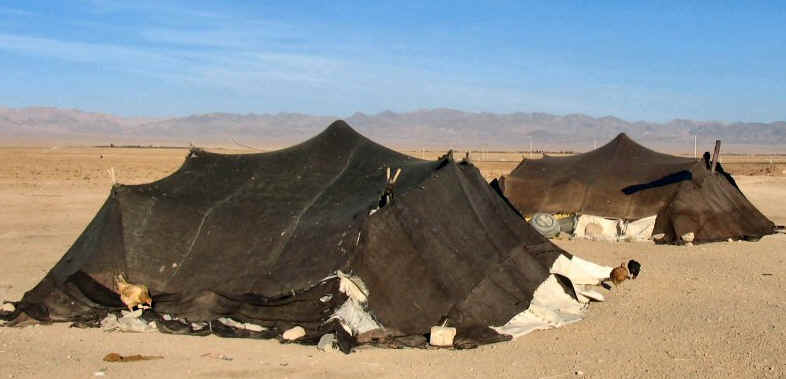A Bedouin tent is an example of the so-called portable or nomadic architecture, which means that it can be easily moved or transported (Bloom, 44). Although some people believe that such a form of construction is very primitive, and one does not have to possess special knowledge or sophistication to erect or dismantle such a tent. It should be noted that this belief is based on a common misconception. While constructing a tent, Bedouins usually have to take into consideration the following factors: climate, lightning, and certainly privacy of the inhabitants.
Arid and hot climate imposes very stringent restrictions on Bedouins; it is necessary to develop a system of ventilation, which enables the cold air to permeate inside. This function is usually performed by the walls, or by the fabric to be more exact. As a rule, it is woven from sheep or goat hair, which has extraordinary thermal endurance. Additionally, we should say that the goat hair is usually painted in black because it better consumes heat (See Picture 1). One should pay extra attention to the special technique of weaving, employed by Bedouin women; it is often called “loose” (Rudofsky, 61).

The main peculiarity is that the tent, made of such material, allows air circulation, which is crucial especially under desert conditions. In fact, it virtually prevents people from suffocating. As regards air circulation, it should be pointed out that Bedouins often made a vent-hole at the top of the tent; naturally, the major effect is achieved through the fabric, but this vent-hole serves some other purpose. One cannot eliminate the possibility of rain, though it is very slim.
We need to mention the material, of which Bedouin tents are made, the sheep hair. When it begins to rain, the fiber distends and becomes waterproof and practically impenetrable, including the air. This aperture sustains circulation. One should also bear in mind that the desert climate could be characterized by significant temperature drops, at night it can get very cold. The material, made of goat hair preserves warm air inside the tent.
Another problem, which Bedouin have to solve, is the question of lighting. It is not always permissible to burn an oil lamp inside the tent because it requires much oxygen and subsequently makes the air very stuffy (Hillenbrand, 55). As it has been mentioned before, Bedouin employ the so-called “loose weave” and the light can easily penetrate through the fabric, therefore, the interior is always well-illuminated (See Picture 2). Certainly, at nighttime, oil lamps have to be burned but for that purpose, additional vent-holes are made. Thus, the problem of illumination can be easily overcome; furthermore, we may also say that the solution does not have to be very complicated, though it is impossible to call it primitive.

There are various types of Bedouin tents; they may vary not only in terms of size but in terms of elaboration as well. They may have various subdivisions or even rooms (if this formulation is appropriate). The “curtain” walls play the role of such dividers. Moreover, very often inhabitants of such tents put up some sort of fence, which prevents other people from intrusion. It is not easily to violate the privacy of other people, who live in the tent. Nonetheless, it is more prudent to discuss this question within cultural context.
Therefore, it is quite possible for us to arrive at the conclusion that a Bedouin tent should not be regarded as something primitive or unsophisticated because one has to possess certain knowledge to construct it, particularly, if we are speaking about ventilation and illumination.
Bibliography
Bernard Rudofsky. “Architecture Without Architects” UNM Press, 1987.
Jonathan M. Bloom. “Early Islamic Art and Architecture”. Ashgate, 2002.
Robert Hillenbrand. “Islamic architecture: form, function, and meaning” Columbia University Press, 1994.